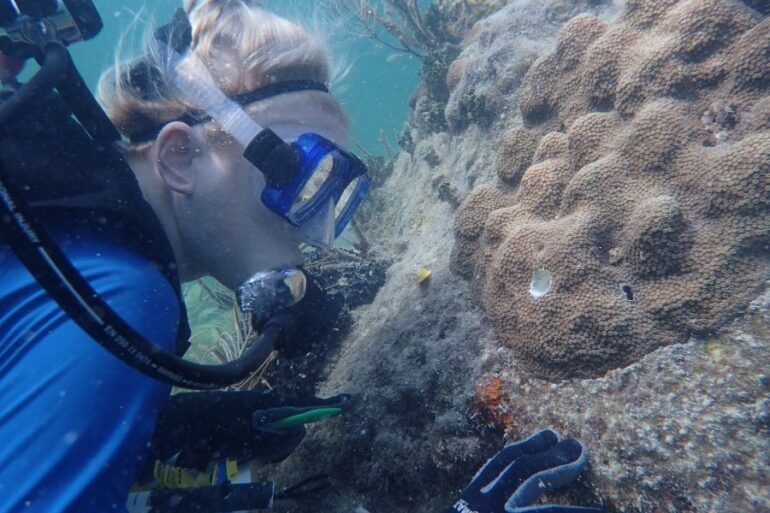BREAKTHROUGH: RESTORED CORALS READY TO BECOME PARENTS
August 4, 2020—Sarasota, FL—For the first time, massive corals restored to Florida’s Coral Reef are ready to become parents in the wild—a breakthrough in Mote Marine Laboratory’s scientific efforts to restore critically imperiled coral reefs.
This month, Mote’s coral reproduction scientist, Dr. Hanna Koch, identified gametes (eggs and sperm) inside colonies of two threatened, yet key, reef-building species that Mote restored to Florida Keys reefs in recent years: the massive or mounding species called mountainous star coral (Orbicella faveolata) and branching staghorn coral (Acropora cervicornis). Both species are listed as Threatened under the Endangered Species Act. The presence of gametes indicates that these corals are sexually mature, gravid (pregnant), and ready to produce the next generation of coral “babies” with fresh genetics to help revive declining coral populations.
These corals are achieving critical milestones for the entire field of coral reef restoration—showing the first signs that they are capable of producing new generations of corals on their own. These and other corals in Mote’s restored populations survived big challenges to reach this point, demonstrating resilience.

Their success validates the significance and progress of Mote’s science-based, resilience-focused coral restoration. The mountainous star coral (O. faveolata) colonies, which Mote outplanted in 2015 off of Cook Island near Big Pine Key, are the first corals of any massive or mounding species that have been documented to produce gametes (i.e., be sexually mature) after being restored in Florida or Caribbean waters.
Sexual maturity is size-dependent in stony corals; slow-growing massive species like mountainous star coral—which tends to grow less than 1 centimeter per year—can take decades to grow from “baby” size to sexually mature size. However, using the propagation and outplanting methodology that Mote pioneered, which is called “microfragmentation-fusion” or “reskinning,” larger colonies of corals can be generated faster. Instead of decades, Mote can now produce sexually mature mountainous star corals in as little as five years (more details below under “what this means”).
Even more encouraging is that these restored corals endured a global bleaching event in 2015, a Category-4 hurricane (Irma) in 2017, and the 2019 outbreak at this site of stony coral tissue loss disease, which has affected millions of reef corals across Florida’s Coral Reef and beyond.



